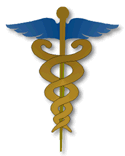
The Head Wound
It has been a massive, thirty-year plus campaign by conspiracy books, videos, filmmakers like Oliver Stone, and conspiracy promoters on the Internet. The campaign has been to push Kennedy's head wound to the very back of his head, in occipital bone, in order to promote the idea of a shooter from the Grassy Knoll.
And indeed, some of the witness testimony points to a large wound on the "back" of Kennedy's head. But, in order to make this argument, conspiracy authors have had to engage in massive selectivity in the use of evidence. And they have had to ignore or declare to be faked the best evidence — movies from Dealey Plaza, and photos and x-rays from the Bethesda autopsy.
Just what do lone assassin theorists, and conspiracy theorists, say about the head wound?
The following are four versions of what the head wound looked like. They can be used as a benchmark as you look at the evidence. Two support the idea of a lone shooter in the School Book Depository, and two support the idea of a shooter from the Grassy Knoll.
Warren Commission
The drawing at right, a Warren Commission Exhibit, was done by Naval Corpsman R.A. Rydberg, in colloboration with Commander Humes and Commander Boswell, the autopsists. None of the three had access to the autopsy photos and x-rays, so the drawing is based entirely on memory. |
| 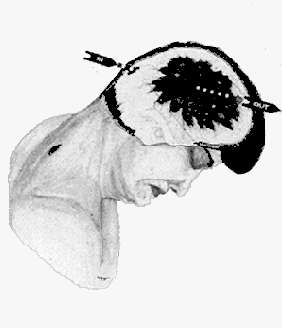 |
Early Conspiracy Version
Josiah Thompson's 1967 book Six
Seconds in Dallas contained the drawing on the right, which was
attributed to Dr. Robert McClelland, one of the doctors who treated
Kennedy in the Parkland Emergency Room. In fact, McClelland neither drew nor approved the drawing. Rather it was done by a medical illustrator based on McClelland's verbal description. |
|  |
Groden Version
The image at right is taken from Robert Groden's The Killing of a President. It represents mainstream thinking among conspiracy theorists, who now mostly admit that the top of the head was damaged, but who continue to insist that the back of the head was blown out.
You may click on the image to see a larger version.
(Sculpture by Edward L Chiarini Jr.)
|
| 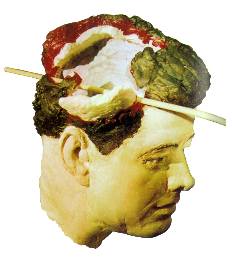 |
House Select Committee
Medical illustrator Ida Dox, working for the House Select Committee's Forensic Pathology Panel in the late 1970s, produced the drawing at right. It faithfully reflects what the autopsy photos and x-rays show, although it is simplified a bit and the fragments aren't drawn to scale. You may click on the image to see a larger version. |
| 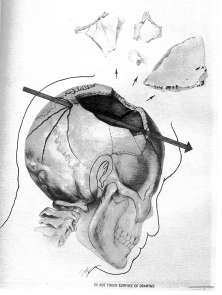 |
What Does the Evidence Show?
Dealey Plaza Head Wound Witnesses
These are the people who watched in awe and horror as Kennedy's head exploded in Dealey Plaza. How do they describe the wound?
Dealey Plaza "Gore" Witnesses
These are the people who, although they didn't see Kennedy's head explode, saw and sometimes felt the results of the explosion.
Dealey Plaza Photographic Evidence
Three amateur photographers were in Dealey Plaza, and captured the head shot with their 8 mm. cameras with enough resolution to allow us to see the explosion of brain matter from Kennedy's head.
|
Other Views
The traditional conspiracy view of the head wound -- that Kennedy was hit from the right front and occipital bone was blown out -- is contradicted by a massive amount of evidence. That's not to say, however, that there is no controversy among sensible researchers.
Independent-minded researcher Paul Seaton believes that the back of Kennedy's head was indeed open at Parkland Hospital, and that the witnesses who describe an occipital wound are correct. Right or wrong, Seaton's web site has numerous resources worth checking out.
Likewise, John Canal believes that Kennedy was hit in the back of the head, but not high in the cowlick area as the expert panels of forensic pathologists believe, but rather near the external occipital protuberance, as the original autopsy doctors asserted.
He makes his case in three essays:
|
|
Parkland and Bethesda Eyewitnesses
These are the witnesses most often quoted in conspiracy books, since many of them said the massive head wound was located in the "back" or "posterior" portion of his head. Are they really as uniform as the conspiracy books say? And could the Parkland doctors actually see the back of Kennedy's head? Gary Aguilar has produced a compilation of testimony which leads him to conclude that 44 of 46 Parkland and Bethesday witnesses saw a large defect in the "back" of Kennedy's head. Did all these witnesses really see a wound that implied a shooter from the Grassy Knoll? The following is a series of critiques of Aguilar's use of witnesses.
What Does "Occipital" Mean?
Conspiracy books are always quoting Parkland and Bethesda witnesses saying Kennedy's head wound was "occipital" or "occipital-parietal." This supposedly means that the back of the head was blown out, as depicted in the McClelland drawing (above). But the reality is that the word "occipital" isn't used so precisely as the conspiracy books believe.
Could the Dallas Doctors Have Seen the Back of Kennedy's Head?
If someone describes a wound as "posterior" or "occipital-parietal" or "back of the head," just what do they mean? One thing is certain, they can only be describing a wound that they might have actually seen. With Kennedy lying supine, and blood and a huge mass of brain tissue oozing from the wound, most could have had no precise knowledge about the extent of the wound.
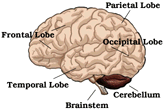
Did the Dallas Doctors See Cerebellum?
Several of the Dallas doctors said they saw, in the mangled mess that was Kennedy's head wound, tissue from the cerebellum. Since the cerebellum is nestled at the very bottom of the brain at the back, this would be strong evidence of a wound low in occipital bone. But were the doctors right?
Autopsy Photos and X-rays
If the autopsy photos and x-rays are genuine, they trump any of the eyewitness testimony the conspiracy books offer. So of course, conspiracy books and videos almost uniformly insist that they are faked. What do the photos and x-rays show, and what did the top photo experts in the country conclude about the charges of fakery?
The Harper Fragment
The Harper Fragment was a piece of bone, apparently from Kennedy's head, that was recovered in Dealey Plaza the day after the assassination. Conspiracy theorists insist that the bone was occipital bone, implying that the back of Kennedy's head was blown out. Dr. Joseph Riley, a conspiracy-oriented physician, evaluates this claim.
Brain Matter Hit Bobby Hargis
Motorcycle cop Bobby Hargis, riding to Kennedy's left and a bit behind him, was hit by matter blown out of Kennedy's skull. Does his testimony prove a shot from Kennedy's right front, the direction of the Grassy Knoll?
Parkland Doctors Confront the Autopsy Photos and X-rays
If the photos and x-rays from the autopsy are really forged, then the doctors from Parkland Hospital ought to see large discrepancies between autopsy materials and what they remember from the emergency room. In 1988, NOVA took four of the Parkland doctors to the National Archives, and showed them the entire set of photos and x-rays. This page records their reaction.
Was the Left Side of Kennedy's Head Wounded?
There is indeed substantial evidence of that, as shown by this essay by Russell Kent, on the now defunct Dealey Plaza UK web site. But does this "substantial evidence" mean there was a wound to the left side of Kennedy's head, or does it mean that if dilligent researchers dig through enough testimony they can find "substantial evidence" of the most unlikely propositions? Conspiracy books tend to downplay or omit this evidence entirely, since it suggests that witness testimony isn't very reliable.
• Impeach Photos and X-rays With Witness Testimony?
Yes, that's what conspiracy theorists will try to do. Faced with autopsy photos and x-rays showing that Kennedy was hit by two bullets from behind, they will marshall witnesses whose accounts conflict with the autopsy photos and x-rays. They will then insist that the photos and x-rays must be faked. How reliable is witness testimony?
On May 18, 1998, Jeremy Gunn of the Assassination Records Review Board spoke at Stanford University. As the chief staff person for the Board, he had an intimate familiarity with the Parkland Hospital and Bethesda autopsy witnesses, many of whom he had interviewed. His conclusion about witness testimony was as follows:
The last thing I wanted to mention, just in terms of how we
understand the evidence and how we deal with what we have is what I
will call is the profound underscore profound unreliability of
eyewitness testimony. You just cannot believe it. And I can tell you
something else that is even worse than eyewitness testimony and that
is 35 year old eyewitness testimony.
I have taken the depositions of several people who were involved in
phases of the Kennedy assassination, all the doctors who performed the
autopsy of President Kennedy and people who witnessed various things
and they are profoundly unreliable.
First published on the web on the Fair Play web site, you might want to check out the entire speech.
Likewise, the Final Report of the ARRB stressed the problems with witness testimony:
Finally, a significant problem that is well known to trial lawyers, judges, and
psychologists, is the unreliability of eyewitness testimony. Witnesses frequently, and
inaccurately, believe that they have a vivid recollection of events. Psychologists and
scholars have long-since demonstrated the serious unreliability of people's
recollections of what they hear and see. One illustration of this was an interview
statement made by one of the treating physicians at Parkland. He explained that he
was in Trauma Room Number 1 with the President. He recounted how he observed
the First Lady wearing a white dress. Of course, she was wearing a pink suit, a fact
known to most Americans. The inaccuracy of his recollection probably says little
about the quality of the doctor's memory, but it is revealing of how the memory
works and how cautious one must be when attempting to evaluate eyewitness
testimony.
The deposition transcripts and other medical evidence that were released by the
Review Board should be evaluated cautiously by the public. Often the witnesses
contradict not only each other, but sometimes themselves. For events that transpired
almost 35 years ago, all persons are likely to have failures of memory. It would be
more prudent to weigh all of the evidence, with due concern for human error, rather
than take single statements as "proof" for one theory or another.
|
 Return
to Kennedy Assassination Home Page
Return
to Kennedy Assassination Home Page





